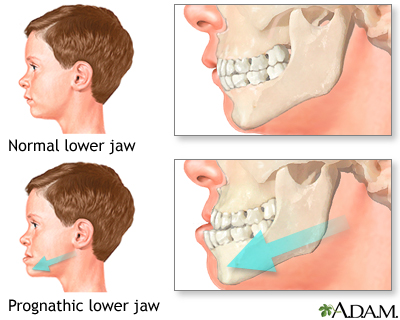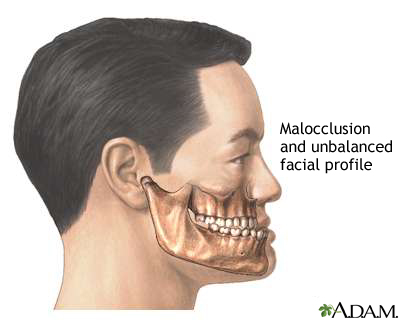Health Library
Prognathism
Extended chin; Underbite
Prognathism is an extension or bulging out (protrusion) of the lower jaw (mandible). It occurs when the teeth are not properly aligned due to the shape of the face bones.
Images


I Would Like to Learn About:
Considerations
Prognathism may cause malocclusion (misalignment of the biting surfaces of the upper and lower teeth). It can give a person an angry, or fighter's appearance. Prognathism may be a symptom of other syndromes or conditions.
Causes
An extended (protruding) jaw can be part of a person's normal face shape that is present at birth.
It can also be caused by inherited conditions, such as Crouzon syndrome or basal cell nevus syndrome.
It may develop over time in children or adults as the result of excess growth in conditions such as gigantism or acromegaly.
When to Contact a Medical Professional
A dentist or orthodontist may be able to treat abnormal alignment of the jaw and teeth. Your primary health care provider should also be involved to check for underlying medical disorders that can be associated with prognathism.
Contact a provider if:
- You or your child have difficulty talking, biting, or chewing related to the abnormal jaw alignment.
- You have concerns about jaw alignment.
What to Expect at Your Office Visit
The provider will perform a physical exam and ask questions regarding your medical history. Questions may include:
- Is there any family history of an unusual jaw shape?
- Is there difficulty talking, biting, or chewing?
- What other symptoms do you have?
Diagnostic tests may include:
- Skull x-ray (panoramic and cephalometric)
- Dental x-rays
- Imprints of the bite (a plaster mold is made of the teeth)
This condition may be treated with surgery. An oral surgeon, plastic facial surgeon, or ENT specialist may perform this surgery.
References
Baker SB, Chang BL, Singh A. Cleft and craniofacial orthognathic surgery. In: Losee JE, Hopper RA, eds. Plastic Surgery: Volume 3: Craniofacial, Head and Neck Surgery and Pediatric Plastic Surgery. 5th ed. Philadelphia, PA: Elsevier; 2024:chap 21.11.
Dhar VK. Malocclusion. In: Kliegman RM, St. Geme JW, Blum NJ, et al, eds. Nelson Textbook of Pediatrics. 22nd ed. Philadelphia, PA: Elsevier; 2025:chap 355.
Koroluk LD, Jackson TH. Adolescent patients. In: Stefanac SJ, Nesbit SP, eds. Diagnosis and Treatment Planning in Dentistry. 4th ed. St Louis, MO: Elsevier; 2024:chap 17.
BACK TO TOPReview Date: 3/31/2024
Reviewed By: Michael Kapner, DDS, General Dentistry, Norwalk Medical Center, Norwalk CT. Review provided by VeriMed Healthcare Network. Also reviewed by David C. Dugdale, MD, Medical Director, Brenda Conaway, Editorial Director, and the A.D.A.M. Editorial team.
 | A.D.A.M., Inc. is accredited by URAC, for Health Content Provider (www.urac.org). URAC's accreditation program is an independent audit to verify that A.D.A.M. follows rigorous standards of quality and accountability. A.D.A.M. is among the first to achieve this important distinction for online health information and services. Learn more about A.D.A.M.'s editorial policy, editorial process and privacy policy. A.D.A.M. is also a founding member of Hi-Ethics. This site complies with the HONcode standard for trustworthy health information: verify here. |
The information provided herein should not be used during any medical emergency or for the diagnosis or treatment of any medical condition. A licensed medical professional should be consulted for diagnosis and treatment of any and all medical conditions. Links to other sites are provided for information only -- they do not constitute endorsements of those other sites. No warranty of any kind, either expressed or implied, is made as to the accuracy, reliability, timeliness, or correctness of any translations made by a third-party service of the information provided herein into any other language. © 1997- 2025 A.D.A.M., a business unit of Ebix, Inc. Any duplication or distribution of the information contained herein is strictly prohibited.
